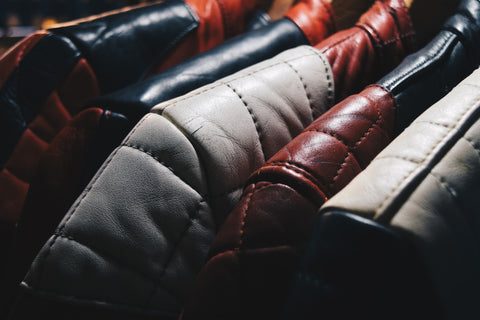Different Types of Leather
Table of Contents

Leather production is an ancient human activity. As long ago as the fifth millennium BC the Sumerians were fashioning long dresses from cured animal skins; the ancient Egyptians made leather gloves and the Phoenicians used it to construct water pipes. Most leather today is a by-product of the meat industry and is taken from cows because of their availability, their size and the quality of the leather. Leather is also taken from a wide range of other animals such as pigs, sheep, deer, horses and kangaroos. More exotic leathers come from ostriches, alligators, snakes, frogs and a variety of fish.
Each type of leather will have a particular set of qualities, uses and appearance. The quality of leather produced from a specific animal is influenced by a range of factors. Some of these are to do with the conditions in which the animal lived: diet, nutrition and climate or exposure to disease, for example. Other factors which affect the quality of the leather come into play once the animal has been slaughtered, such as the tanning chemicals and the dyes and stains which have been used, as well as the shipping and handling methods.
A tanned cowhide can have a thickness of up to ten millimetres, but the full thickness of a hide is rarely used, except for belts. The uppermost surface of the hide is the side from which the hair has been removed. The inner layer is where the hide originally connected to the flesh. The fibre structure of the leather varies throughout the thickness of the hide, being tightest and densest at the upper layer and looser toward the lower side.
Full Grain Leather
Full Grain Leather is the top layer of the hide. It is treated with aniline dyes which are soluble and do not mask the hide’s natural surface. Sometimes a semi-aniline dye is used which will give the leather a thin protective top coat and prevent staining. The vertical fibres of this part of the leather make it the strongest and most durable part of the hide, it will not crack or peel, tear or puncture. The grain pattern is tight and consequently resistant to moisture. Part of the beauty of Full Grain leather is its unique appearance: every piece tells the story of the animal. All markings and irregularities are preserved: scars where the animal has brushed against a barbed wire fence or cactus, insect bites, even brand marks or wrinkles. As anyone who has owned Full Grain Leather will know, it becomes more beautiful with age, developing a rich patina as the years go by. It is the only type of leather which ages in this way. It is in short, the best leather that money can buy, which is why it is the main leather used by MAHI for the majority of our products.
Top Grain Leather
Rather confusingly, this is not the top layer of the hide but the second layer. The surface of the leather has been removed by sanding and buffing in order to remove the ‘imperfections’. This gives the leather a more uniform appearance but it also means that the leather is much less durable than Full Grain leather and that it will deteriorate much faster. Top Grain leather is the most commonly used leather for the production of quality goods because it is thinner, more pliable and less expensive than Full Grain. A variant of Top Grain leather is ‘Corrected’ leather. This is Top Grain leather which has gone through an extensive process of sanding, buffing, stamping and dyeing in order to achieve a uniform appearance in which all natural markings have been removed.
Nubuck Leather
Originally made from the hide of deer or elk, Nubuck shoes were first made fashionable by the visit of the Duke of Windsor to America in the 1930s. Nubuck is Top Grain Leather which has not been processed but the surface has been brushed and polished so that the short protein fibres produce a velvet surface. Similar to suede, but more expensive, the lush surface will change shade when you run your hand over it. Stronger and thicker than suede it can be white or coloured and dyed. It has a rougher appearance than suede and may retain natural markings.
Suede
Suede is leather made from the inner layer of the hide, the side originally in contact with the flesh of the animal. The surface is sanded and buffed and the resulting leather is softer and more flexible than Nubuck, but not nearly as tough. Its absorbent surface makes it vulnerable to staining. We use this for some of our leather jackets.
Faux or Synthetic Leather

A by-product of the chemical industry, synthetic leathers have been in production since the 1940's. Produced under a wide range of brand names, synthetic leathers fall into two main groups: polyurethane (PU) and polyvinyl chloride (PVC, Vinyl).
Vinyl upholstery became a popular cheap option for car interiors and utility furniture such as might be found in hospitals or budget restaurants. Durable and easy to maintain, vinyl becomes sticky and unpleasant when in contact with human skin. Polyurethane fabric is softer, more flexible and to a certain extent more breathable, it can be printed to create a plausible visual imitation of leather although it is entirely different to the touch. It is more expensive than Vinyl but still considerably cheaper than leather.
New synthetic leathers have been created which mimic the chemical structure of real leather. It is claimed that these synthetic leathers are even stronger and more durable than real leather but their production is expensive and environmentally problematic. They are produced using petrochemicals which are both non-renewable and non-biodegradable. There are also concerns that the microfibres used in the production of these synthetic leathers are starting to enter the food chain. Items washed in washing machines are shedding non-degradable fibres which are subsequently finding their way into rivers and lakes.

















